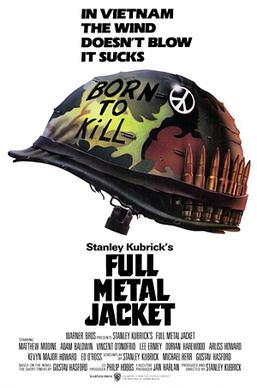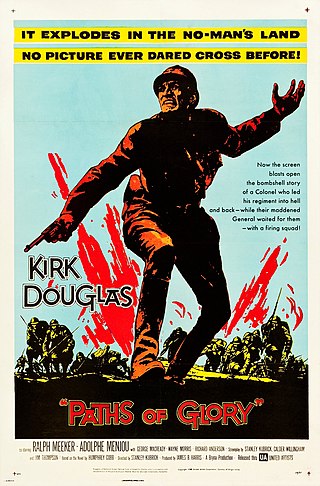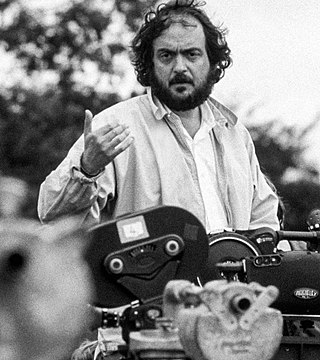
Dr. Strangelove or: How I Learned to Stop Worrying and Love the Bomb is a 1964 political satire black comedy film cowritten, produced, and directed by Stanley Kubrick and starring Peter Sellers in three roles, including the title character. The film, financed and released by Columbia Pictures, was a co-production between the United States and the United Kingdom.

Eyes Wide Shut is a 1999 American erotic mystery psychological drama film directed, produced, and co-written by Stanley Kubrick. It is based on the 1926 novella Traumnovelle by Arthur Schnitzler, transferring the story's setting from early twentieth-century Vienna to 1990s New York City. The plot centers on a physician who is shocked when his wife reveals that she had contemplated having an affair 12 months earlier. He then embarks on a night-long adventure, during which he infiltrates a masked orgy of an unnamed secret society.

Full Metal Jacket is a 1987 war drama film directed and produced by Stanley Kubrick, who also cowrote the screenplay with Michael Herr and Gustav Hasford. The film is based on Hasford's 1979 novel The Short-Timers and stars Matthew Modine, R. Lee Ermey, Vincent D'Onofrio and Adam Baldwin.

Paths of Glory is a 1957 American anti-war film co-written and directed by Stanley Kubrick, based on the novel of the same name by Humphrey Cobb. Set during World War I, the film stars Kirk Douglas as Colonel Dax, the commanding officer of French soldiers who refuse to continue a suicidal attack, after which Dax attempts to defend them against charges of cowardice in a court-martial.

Stanley Kubrick was an American filmmaker and photographer. Widely considered one of the greatest filmmakers of all time, his films were nearly all adaptations of novels or short stories, spanning a number of genres and gaining recognition for their intense attention to detail, innovative cinematography, extensive set design, and dark humor.

Irwin Lawrence "Paul" Mazursky was an American film director, screenwriter, and actor. Known for his dramatic comedies that often dealt with modern social issues, he was nominated for five Academy Awards for Bob & Carol & Ted & Alice (1969), An Unmarried Woman (1978), Harry and Tonto (1974), and Enemies, A Love Story (1989). He is also known for directing such films as Next Stop, Greenwich Village (1976), Moscow on the Hudson (1984), Down and Out in Beverly Hills (1986), Moon over Parador (1988), and Scenes from a Mall (1991).

Red Alert is a 1958 novel by Peter George about nuclear war. The book provided the underlying narrative structure for Stanley Kubrick's 1964 film Dr. Strangelove or: How I Learned to Stop Worrying and Love the Bomb. Kubrick's film differs significantly from the novel in that the film is a black comedy.
Section 8 was a category of discharge from the United States military, used for a service member judged mentally unfit for service. Section 8 was also often given to cross-dressers, gay, lesbian, bisexual and transgender people.

Killer's Kiss is a 1955 American independently-produced crime film noir directed by Stanley Kubrick and written by Kubrick and Howard Sackler. It is the second feature film directed by Kubrick, following his 1953 debut feature Fear and Desire. The film stars Jamie Smith, Irene Kane, and Frank Silvera.

A Clockwork Orange is a 1971 dystopian crime film adapted, produced, and directed by Stanley Kubrick, based on Anthony Burgess's 1962 novel of the same name. It employs disturbing, violent images to comment on psychiatry, juvenile delinquency, youth gangs, and other social, political, and economic subjects in a dystopian near-future Britain.

Frank Alvin Silvera was a Jamaican-born American character actor and theatrical director.
Howard Oliver Sackler was an American screenwriter and playwright who is best known for having written The Great White Hope. The Great White Hope enjoyed both a successful run on Broadway and, as a film adaptation, in movie theaters. James Earl Jones and Jane Alexander both starred in the original Arena Stage production of the play in Washington, DC, then brought their roles to Broadway and later to the film version. Both Jones and Alexander received Academy Award nominations for their work in the movie.

Follow the Boys also known as Three Cheers for the Boys is a 1944 musical film made by Universal Pictures during World War II as an all-star cast morale booster to entertain the troops abroad and the civilians at home. The film was directed by A. Edward "Eddie" Sutherland and produced by Charles K. Feldman. The movie stars George Raft and Vera Zorina and features Grace McDonald, Charles Grapewin, Regis Toomey and George Macready. At one point in the film, Orson Welles saws Marlene Dietrich in half during a magic show. W.C. Fields, in his first movie since 1941, performs a classic pool-playing presentation he first developed in vaudeville four decades earlier in 1903.

Next Stop, Greenwich Village is a 1976 American comedy-drama film written and directed by Paul Mazursky, featuring Lenny Baker, Shelley Winters, Ellen Greene, Lois Smith, and Christopher Walken.
The Stanley Kubrick Archive is held by the University of the Arts London in their Archives and Special Collection Centre at the London College of Communication. The Archive opened in October 2007 and contains material collected and owned by the film director Stanley Kubrick (1928–1999). It was transferred from his home in 2007 through a gift by his family. It contains much of Kubrick's working material that was accumulated during his lifetime.
Joseph Burstyn was a Polish-American film distributor who specialized in the commercial release of foreign-language and American independent film productions.

Virginia Leith was an American film and television actress.

The following is a list of unproduced Stanley Kubrick projects in roughly chronological order. During his long career, American film director Stanley Kubrick had worked on a number of projects which never progressed beyond the pre-production stage under his direction. Some of these projects fell into development hell or are officially cancelled.

Stanley Kubrick (1928–1999) directed thirteen feature films and three short documentaries over the course of his career. His work as a director, spanning diverse genres, is widely regarded as extremely influential.
Part of the New Hollywood wave, Kubrick's films are considered by film historian Michel Ciment to be "among the most important contributions to world cinema in the twentieth century", and he is frequently cited as one of the greatest and most influential directors in the history of cinema. According to film historian and Kubrick scholar Robert Kolker, Kubrick's films were "more intellectually rigorous than the work of any other American filmmaker."















